Entertainment’s New Social Draw
Williams Reports on the Emerging Social Entertainment Scene & Says Hospitality & Games Have Become “Blended into a Very Popular Cocktail”

by Kevin Williams
It seems that the social element of entertainment is being constantly championed – fuelled in part by its association with social media but also because of the post-Covid desire of people to get together again … and in social spaces! This was a growing international trend before the privations of the last two years and one that has accelerated since.
Exploding in popularity is a new trend in the out-of-home entertainment landscape called “Competitive Socializing,” defined as the mixing of the hospitality (bar, tavern and cocktail lounge) with a competitive, socially inclusive entertainment experience. The concept can trace its roots back to arcade bars, bar-bowling and even something as commonplace as the placement of amusement equipment in bars and taverns. But, it is the creation of a highly specialized environment –– one that appeals directly to the young adult audience and comprises upscale entertainment offerings –– that singles out this latest application.
For an entertainment medium to be a fit for Competitive Socializing environments, they need to support group activity, allowing groups of friends to take part and have casual fun – but with some level of competition or “gamification.” They also need to be able to incorporate a drink and dining component. And they need to be far removed from any kind of home entertainment equivalent. The key is that these new venues are being created to pull the audience out from their comfortable homes to socialize with friends.
The term Competitive Socializing originates from the U.K., a sector that has grown up with bar games in pubs and clubs. It was in the early 2000s that venues started to break the mold regarding the mixing of entertainment, theming and hospitality. Examples are bowling establishments like All Star Lanes, which mixes a circus theme, good food and drink within an incredibly social space people wanted to be part of. By 2015, the term was becoming a popular watchword for the growth of a new entertainment element, and the first chains that followed this model made their impact.
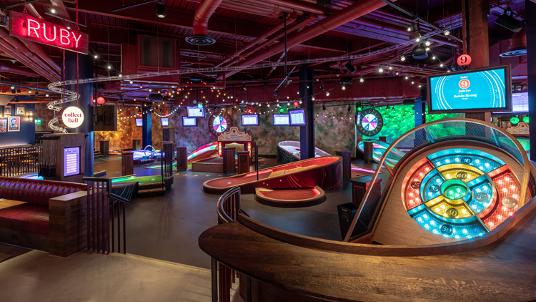
The socializing of “crazy golf” has been one aspect of the trend that has seen much activity. (“Crazy golf” is a type of mini-golf.) U.K.-based Puttshack can trace its lineage back to its founders who established the TopGolf operation which socializes the golf shooting range. It was only logical that the gamified technology of a tracked ball and scoring, linked to a highly social hospitality environment, would take on crazy golf. The operation has exploded onto the scene, first with U.K. venues, and now with dedicated rollout plans across the U.S., seeing sites in Atlanta (opening this year) with Miami and Chicago by 2023.
The entertainment offering of both miniature golf and crazy golf have become both indoor and outdoor social experiences for young adult group entertainment. This is best illustrated by the entry of golfing legend Tiger Woods, who has rolled out his PopStroke chain with two sites already open in Florida, and plans for another two before the end of the year.
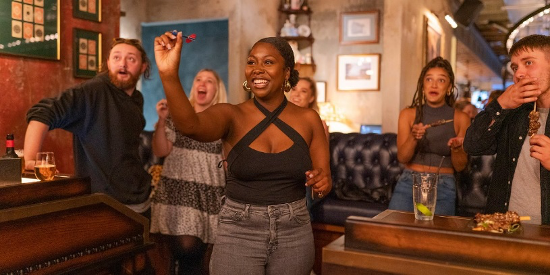
An aspect of the Competitive Socializing trend’s tavern roots has seen one of the most iconic British pastimes –– playing darts –– given the social treatment. The company that initially co-founded Puttshack, State of Play Hospitality, has a background in applying a strong hospitality mix to the entertainment medium. Their Flight Club chain takes traditional darts and adds a social game element with video screens encouraging the competition. It’s not just about calculating scores but also offering a fun competition.
While these new venues use steel-tipped darts, they are using specially sourced interactive systems. Having distanced themselves from traditional amusement electronic darts machines. Other social entertainment sites are deploying new gamification technology being applied to the mix, with Augmented Reality (AR) dart experiences. Developer 501 Entertainment has created a suite of technology that focuses on this emerging scene. Their Smart Darts platform incorporates projection-mapped overlays on the dart board along with seamless connectivity through touchscreens for ordering and game selection.
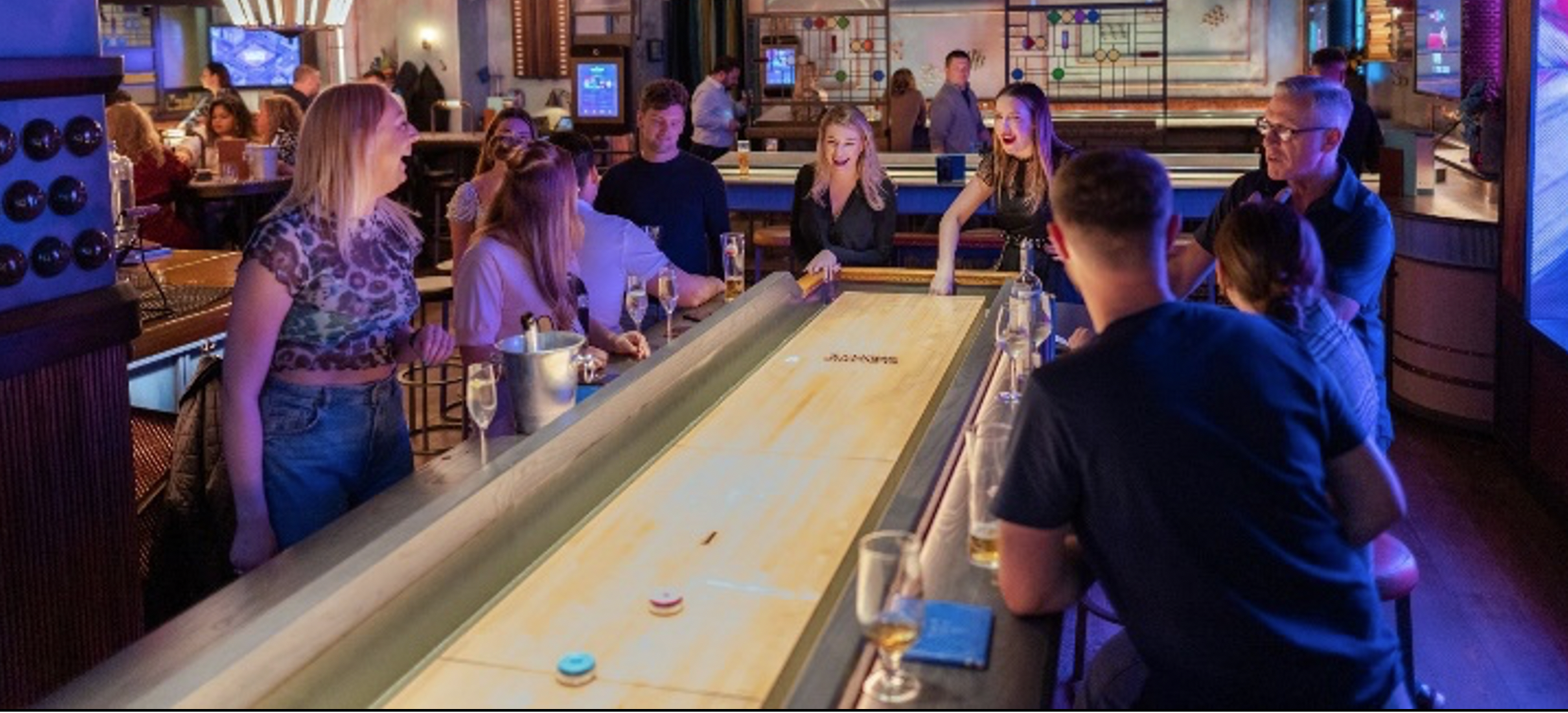
501 has also applied this tech to the old American bar standard, the shuffleboard. With Shuffle Pucks, 501 has created an experience that’s not greatly changed from the familiar play, but now has been made more inclusive, presented in a way to offer maximum service and appeal. With scoring through a unique touchscreen interface (also part of the ordering system), Shuffle Pucks creates what the company feels is a much more socially engaging experience.
One of the growing applications of this social gamification approach is also seen in the bowling sector. Traditional league bowling establishments continue to be swept aside for trendy and immersive bowling environments with the latest large-screen projection and a new “play-and-stay” methodology. Group entertainment here has been gamified beyond keeping a score as the use of projection mapping and tracking allows the bowling element to be a game beyond just the scoring. As one example, TouchMagix has partnered with Brunswick to develop the Spark AR projection system that turns the bowling lane into an interactive experience, incentivizing the player to use the touchscreen kiosk to select games and generate all-important food and beverage sales.
Some of these new styles of venues include Duckpin Bowling as an alternative to full-size lanes, perfect for the needs of the food-and-fun environment. This fits within the casual nature of social entertainment, moving away from the limitations of full-size bowling balls and special footwear.
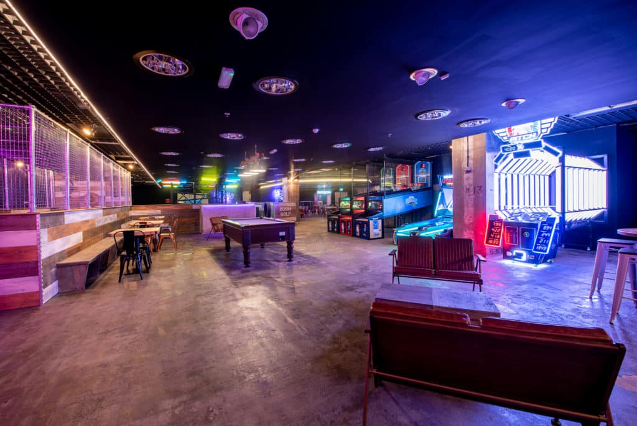
Many of the new mixed entertainment social venues incorporate amusement elements but in a unique and appealing format. We are seeing venues open like the U.K.’s Boom Battle Bar, which incorporates amusements such as coin-op basketball alongside beer pong, pool, crazy golf and even AR darts and axe throwing. The mixed entertainment aspect of this brand offers a much more stylized environment to play and socialize within. Boom Battle has plans to roll out new facilities internationally.
There are also new social entertainment venues that re-imagine the amusement offering, such as Kung Fu Saloon which offers an eclectic mix of vintage video arcade games alongside foosball, shuffleboard and a full bar and scratch-made menu. The ongoing trend of capitalizing on nostalgia in the “Beer-Cade”-style of venue has been exploding and we’ve seen numerous brands open chain operations, such as Barcade, Up-Down and Cobra Arcade Bar to just name three.
While the owners of these new, entrepreneurial operations wouldn’t see themselves as part of the conventional amusement business, in some cases they do establish distribution and support agreements with companies in our industry. Within this social entertainment scene today, opportunities being explored are expanding beyond their more retro-machine focus with the latest photobooth platforms, along with new amusement pieces.
When it comes to gamification, while many of the games involved may seem just slightly modified from their traditional coin-op, out-of-home roots, it is important to note the important inclusion of technology: digital screens, immersive presentations, and scoring (in many cases linked to a smartphone app). These enhancements drive repeat play and appeal to a generation born in the heart of the mobile and console gaming revolution.
While drinking and wielding a sharp object may not spring to mind as a good idea (!), the boom in axe-throwing venues and their social hospitality element, is a testament to the popularity of that form of entertainment. Like darts, gamification has taken play to a new level as seen in venues like Game of Throwing where new “Interactive Target Lane” projection mapping offers new game elements.
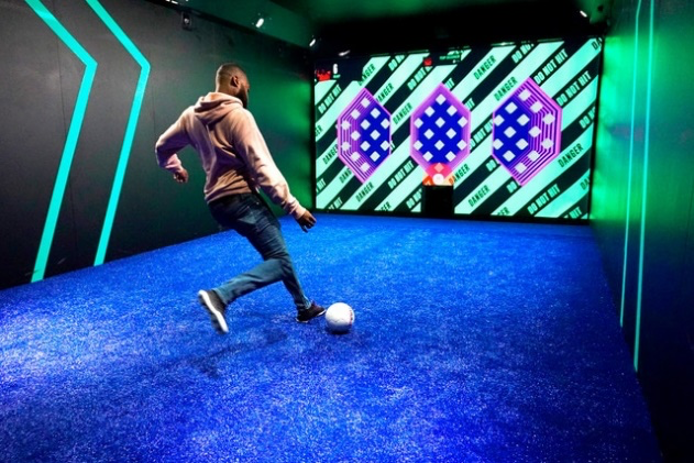
It is this inclusion of AR and projection technologies that is leading to the latest trend in Immersive Entertainment. We are seeing the deployment of enclosures using projection that tracks either the player’s ball/club or whole-body movements, representing this physical activity in the game. This was first seen with golf simulators (one of the largest chains in this scene being Topgolf Swing Suite.) But along with golf, other sports have been replicated in immersive fashion for out-of-home entertainment such as baseball, clay pigeon shooting and soccer (as seen at the new chain TOCA Social).
An example of placing groups of players into the heart of the game was seen in the U.K.- launched Electric Gamebox. Its unique enclosures use tracking on the players’ hats to allow them to control their characters within the projection environment. The company has rolled out several facilities, revealing big U.S plans and in May, opened its sixth location in California. Electric Gamebox recently announcd a licensing agreement with Rovio to offer a life-size Angry Birds game experience on the platform.
A party element is another hallmark of competitive socializing. The mixture of competition, food and drink is one thing, but also the presentation as a personalized group or party experience allows for a high price and more profitable utilization of space. It also removes much of the dependence on passing drop-in foot traffic by putting its focus on groups and party reservations.
In conclusion, it is this social element that defines “competitive socializing” and also the application of FOMO (Fear of Missing Out) experiences, those created to be promoted on social media feeds with lots of “Instagramable” moments. The scene is constantly growing and evolving, and we can expect many more new facility brands to jump into these lucrative waters.
Kevin Williams is a specialist on entertainment and technology. He is a frequent presenter at international conferences and a regular speaker at the Amusement360 bootcamp for LBE and FEC investors. He is also one of the senior judges of the VR Awards.
Kevin’s consultancy, KWP Ltd., helps international clients develop immersive and interactive entertainment. He now combines his services as co-owner and technology director of Spider Entertainment (a global leader in out-of-home entertainment for retail destinations and beyond), and holds advisory positions with other entrants into the market.
Kevin is publisher of the Stinger Report for those working or investing in the amusement, attractions, and entertainment industry. He is also the co-author of the only book on this aspect of the market (the next edition is scheduled for publication in 2023.
Kevin can be reached at kwp@thestingerreport.com.
